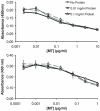Metallothionein (MT) -I and MT-II expression are induced and cause zinc sequestration in the liver after brain injury
- PMID: 22363575
- PMCID: PMC3281953
- DOI: 10.1371/journal.pone.0031185
Metallothionein (MT) -I and MT-II expression are induced and cause zinc sequestration in the liver after brain injury
Abstract
Experiments with transgenic over-expressing, and null mutant mice have determined that metallothionein-I and -II (MT-I/II) are protective after brain injury. MT-I/II is primarily a zinc-binding protein and it is not known how it provides neuroprotection to the injured brain or where MT-I/II acts to have its effects. MT-I/II is often expressed in the liver under stressful conditions but to date, measurement of MT-I/II expression after brain injury has focused primarily on the injured brain itself. In the present study we measured MT-I/II expression in the liver of mice after cryolesion brain injury by quantitative reverse-transcriptase PCR (RT-PCR) and enzyme-linked immunosorbent assay (ELISA) with the UC1MT antibody. Displacement curves constructed using MT-I/II knockout (MT-I/II(-/-)) mouse tissues were used to validate the ELISA. Hepatic MT-I and MT-II mRNA levels were significantly increased within 24 hours of brain injury but hepatic MT-I/II protein levels were not significantly increased until 3 days post injury (DPI) and were maximal at the end of the experimental period, 7 DPI. Hepatic zinc content was measured by atomic absorption spectroscopy and was found to decrease at 1 and 3 DPI but returned to normal by 7DPI. Zinc in the livers of MT-I/II(-/-) mice did not show a return to normal at 7 DPI which suggests that after brain injury, MT-I/II is responsible for sequestering elevated levels of zinc to the liver.
Conclusion: MT-I/II is up-regulated in the liver after brain injury and modulates the amount of zinc that is sequestered to the liver.
Conflict of interest statement
Figures







Similar articles
-
Increased circulating leukocyte numbers and altered macrophage phenotype correlate with the altered immune response to brain injury in metallothionein (MT)-I/II null mutant mice.J Neuroinflammation. 2011 Dec 7;8:172. doi: 10.1186/1742-2094-8-172. J Neuroinflammation. 2011. PMID: 22152221 Free PMC article.
-
Developmental variation in copper, zinc and metallothionein mRNA in brindled mutant and nutritionally copper deficient mice.Biochim Biophys Acta. 1991 Oct 21;1097(3):205-11. doi: 10.1016/0925-4439(91)90036-9. Biochim Biophys Acta. 1991. PMID: 1681908
-
Interferon alpha induction of metallothionein in rat liver is not linked to interleukin-1, interleukin-6, or tumor necrosis factor alpha.Exp Mol Pathol. 2005 Aug;79(1):33-8. doi: 10.1016/j.yexmp.2005.02.005. Epub 2005 Apr 12. Exp Mol Pathol. 2005. PMID: 16005709
-
Expression and regulation of brain metallothionein.Neurochem Int. 1995 Jul;27(1):1-22. doi: 10.1016/0197-0186(94)00164-p. Neurochem Int. 1995. PMID: 7655341 Review.
-
Metallothionein and apoptosis in the toxic milk mutant mouse.Lab Invest. 1998 Feb;78(2):175-83. Lab Invest. 1998. PMID: 9484715 Review.
Cited by
-
Cortex-wide response mode of VIP-expressing inhibitory neurons by reward and punishment.Elife. 2022 Nov 23;11:e78815. doi: 10.7554/eLife.78815. Elife. 2022. PMID: 36416886 Free PMC article.
-
Assessing the Protective Role of Epigallocatechin Gallate (EGCG) against Water-Pipe Smoke-Induced Toxicity: A Comparative Study on Gene Expression and Histopathology.Molecules. 2023 Nov 9;28(22):7502. doi: 10.3390/molecules28227502. Molecules. 2023. PMID: 38005223 Free PMC article.
-
Loss of divalent metal transporter 1 function promotes brain copper accumulation and increases impulsivity.J Neurochem. 2016 Sep;138(6):918-28. doi: 10.1111/jnc.13717. Epub 2016 Jul 22. J Neurochem. 2016. PMID: 27331785 Free PMC article.
References
-
- Giralt M, Penkowa M, Lago N, Molinero A, Hidalgo J. Metallothionein-1+2 protect the CNS after a focal brain injury. Exp Neurol. 2002;173:114–128. - PubMed
-
- Penkowa M, Florit S, Giralt M, Quintana A, Molinero A, et al. Metallothionein reduces central nervous system inflammation, neuro degeneration, and cell death following kainic acid-induced epileptic seizures. J Neurosci Res. 2005;79:522–534. - PubMed
-
- Natale JE, Knight JB, Cheng Y, Rome JE, Gallo V. Metallothionein I and II mitigate age-dependent secondary brain injury. J Neurosci Res. 2004;78:303–314. - PubMed
Publication types
MeSH terms
Substances
LinkOut - more resources
Full Text Sources
Molecular Biology Databases

